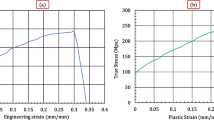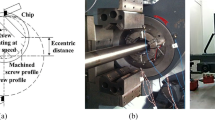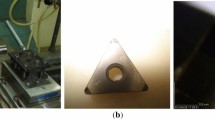Abstract
An investigation into material wrinkling failure mechanics of conventional metal spinning and the effects of process parameters and material properties are presented in this paper. By developing finite element (FE) models using the Box-Behnken design of experiments, the effects of six key process and material parameters on the start of material wrinkling have been investigated. These key factors include roller feed per pass, feed rate, blank thickness, tool path profile, material Young’s modulus, yield stress and strain hardening exponent. The results of FE simulation are validated by comparing the modelled roller tool forces and spun part end shape with those measured during a spinning experiment.
From FE simulations, large residual stresses in the form of bending moments are found to be present in the flange of the blank, induced by the roller contact. It is found that material wrinkling failure begins when a plastic hinge is formed between the roller and the edge of the blank. It is found that both roller feed per pass and feed rate produce the most significant effect on the initiation of wrinkling failure, as they increase the bending stresses causing a plastic hinge to form more rapidly, thus wrinkling to occur more quickly.
Similar content being viewed by others
References
Xia Q, Xiao G, Long H, Cheng X, Sheng X (2014) A review of process advancement of novel metal spinning. Int J Mach Tools Manuf 85:100–121
Runge M (1994) Spinning and flow forming (D. H. Pollitt, Trans). Leifield, GmbH
Wong CC, Dean TA, Lin J (2003) A review of spinning, shear forming and flow forming processes. Int J Mach Tools Manuf 43:1419–1435
Music O, Allwood JM, Kawai K (2010) A review of mechanics of metal spinning. J Mater Process Technol 210:3–23
Sebastiani G, Brosius A, Homberg W, Kleiner M (2007) Process characterization of sheet metal spinning by means of finite elements. Key Eng Mater 334:637–644
Wang L, Long H (2011) Investigation of material deformation in multi-pass conventional metal spinning. Mater Des 32:2891–2899
Music O, Allwood JM (2011) Tool-path design for metal spinning. ICTP Special Issue Sheet Metal Forming, the 10th International Conference on Technology of Plasticity, Aachen, Germany
Senior BW (1956) Flange wrinkling in deep-drawing operations. J Mech Phys Solids 4:235–246
Kobayashi S (1963) Instability in conventional spinning of cones. J Eng Ind 85(1):44–49
Kegg R (1961) A new test method for determination of spinnability of metals. J Eng Ind Trans ASME 83:118–125
Hayama M, Tago A (1968) The fracture of walls on shear spinning—study on the spinnability of aluminium plates. Bull Fac Eng Yokohama National Univ 17:93–103
Kawai K, Hayama M (1987) Roller pass programming in conventional spinning by NC spinning machine. Lange K (ed) Advanced technology of plasticity, Springer, Heidelberg, p 711–718
Hayama M, Murota T, Kudo H (1966) Deformation modes and wrinkling of flange on shear spinning. Bull JSME 9(34):423–433
Hayama M (1981) Study on spinnability of aluminium and its alloys. Bull Fac Eng Yokohama National Univ 30:63–72
Arai H (2003) Robotic metal spinning–shearing spinning using force feedback control. Proceedings of 2003 IEEE, International Conference on Robotics & Automation, Taipei, pp 3977–3983
Xia Q, Shima S, Kotera H, Yasuhuku D (2005) A study of the one-path deep drawing spinning of cups. J Mater Process Technol 159:397–400
Essa K, Hartley P (2009) Numerical simulation of single and dual pass conventional spinning process. Int J Material Form 2:271–281
Wang L, Long H (2011) Investigation of effects of roller path profiles on wrinkling in conventional spinning. Proceedings of 10th International Conference on Technology of Plasticity, Aachen, Germany
Kleiner M, Gobel R, Kantz H, Klimmek C, Homberg W (2002) Combined methods for prediction of dynamic instabilities in sheet metal spinning. CIRP Ann Manuf Technol 51(1):209–214
Wang L, Long H, Ashley D, Roberts M, White P (2011) Effects of the roller feed ratio on wrinkling failure in conventional spinning of a cylindrical cup. Proc IMechE B: J Eng Manuf 225:1991–2006
Wang L, Long H (2013) Roller path design by tool compensation in multi-pass conventional spinning. Mater Des 46:645–653
Hamilton S, Long H (2008) Analysis of conventional spinning process of a cylindrical part using finite element method, Special Edition of Steel Research International, Verlag Stahleisen GmbH, 79(1): 632–639
Liu CH (2007) The simulation of multi-pass and die-less spinning process. J Mater Process Technol 192–193:518–524
Long H, Wang L, Jagger P (2011) Roller force analysis in multi-pass conventional spinning by finite element simulation and experimental measurement. Proceedings of the 10th International Conference on Technology of Plasticity, Aachen, Germany
Wang L, Long H (2011) A study of effects of roller path profiles on tool forces and part wall thickness variation in conventional metal spinning. J Mater Process Technol 211:2140–2151
Wang Q, Wang T, Wang Z R (1989) A study of the working force in conventional spinning. Proceedings of the Fourth International Conference of Rotary Forming, pp. 103–108
Razavi H, Biglari FR, Torabkhani A (2005) Study of strains distribution in spinning process using FE simulation and experimental work. Tehran International Congress on Manufacturing Engineering (TICME2005), Tehran, Iran
Author information
Authors and Affiliations
Corresponding author
Rights and permissions
About this article
Cite this article
Watson, M., Long, H. & Lu, B. Investigation of wrinkling failure mechanics in metal spinning by Box-Behnken design of experiments using finite element method. Int J Adv Manuf Technol 78, 981–995 (2015). https://doi.org/10.1007/s00170-014-6694-6
Received:
Accepted:
Published:
Issue Date:
DOI: https://doi.org/10.1007/s00170-014-6694-6




